 ?
?
Lost in Time...
The Misadventures of Ivan Kozhedub's Famous "White 27"
 ?
?
The Misadventures of Ivan Kozhedub's Famous "White 27"
| Update! Some considerable new material has been submitted by our readers since the first posting of this article. I have pondered this new evidence, and now I wish to update the article to reflect these changes and additions. In this case, I decided that it was better simply to replace the older text; those persons familiar with the original hypothesis are encouraged to read the article again.... EP [June 04] |
Cold War and Cold Brains
During the years of the Cold War, a number of
photographs circulated of "White 27" in the West. The most common was probably
this photograph showing "White 27". This photograph shows the aircraft
on display in the main hall of the Tsentralniy Dom Aviatsiya i Kosmonavtika
(TsDAK), Moscow. As yet, no date has been established for the picture.
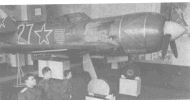
As well, the actual aircraft itself was on public
display in the USSR at the Air Force Museum (Monino), near Moscow. The
physical appearance of the aircraft in the collection (after 1972) looked
then just as it does now.

However, from this relatively nice and useful
evidence--a physical specimen to examine and a clearly developed (if tonally
confusing) B/W photograph--many Western artists derived this colour profile
artwork.
![]()
This same appearance was repeated time and again,
from Facts On File to Air Enthusiast to the various Pilot
Press books to serious aviation art. One has to submit that a description
of this kind of profile as "astonishing" would be over-generous. I, personally,
would love to hear someone attempt to explain how on earth
they managed to derive this colouration from the above photograph (or actual
example).
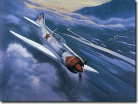
Jerry Crandall's painting of "27"; an unwitting victim
of this amazing stupidity
Or, alternately, we got the typical "green" appearance.

Evidently, every VVS aircraft manufactured between 1925 and 1955 was
either "white" or "green"... (or, of course, the RAF's "green and brown").
Meanwhile, ideas about "White 27" in Eastern Europe
were pretty uniform. In these cases, the artist was usually happy to recreate
the exhibit as it stood at Monino, but with suitable 'modifications' for
its service life in 1945. These would include reducing the HSU badges to
two, and often to depict the spinner in red.

This profile dates from the mid-1970s and comes from Krilya Pobedi
magazine
(via the GMA book Samolet Stalinskikh Sokolov). It is a rendition
of the Monino example, as can be seen, but here also we learn new and amazing
"facts" (for example, that Kozhedub was in the '175 IAP'-- not even a Guard's
unit!!). Stereotypical misconceptions and errors were (and are) by no
means
a Western monopoly.
Other examples of various interpretations exist, as well. Stan Stokes,
another fine aviation artist, offered this painting of "27". Here the artist
has apparently been informed by eyewitnesses of the current colour of "White
27" at Monino. The painting is sufficiently close to AMT-12 to warrant
favourable mention, but the various details are typical of those from Western
literature (i.e. absurd).
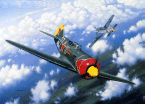
In modern literature we often find "White 27" depicted in a two-colour
camouflage scheme as per the alleged details of the May 1945 photograph.
An attempt has been made in most cases to show something close to AMT-11/-12/-7
colouration.

These views, whatever their merit, must be said to be vastly improved
over the previous... well... rubbish, actually.
"White 27" At War
A most fundamental question presents itself to any researcher when attempting to ascertain the appearance of this aircraft during its service life-- did Kozhedub have only one La-7? The answer to this most basic matter, alas, is actually not known.
When Kozhedub arrived at the 176 GIAP as the Deputy Commander of the Regiment, he was then assigned an La-7 aircraft which he piloted during the successful combats of September 22 and 25. Following these victories, a period of inactivity set in. Kozhedub, along with the better part of two eskadrilya from the 176 GIAP, were dispatched farther to the north by Marshal Novikov to counter a group of enemy 'aces' (the German aces Rudorffer, Nowotney, and Phillip are usually mentioned, but I have no idea if this is correct). Before any air combat activity took place, however, the entire 176 GIAP was thusly relocated, and the northern flank of the 1st Belorussian Front became the Regiment's new operational area. Kozhedub's next known victory occurred on 16 January 1945 in this operational zone.
So, what happened during these three months of inactivity? In the history of the La-7, a lot, as a matter of fact. A number of flight accidents beset the La-7 at just this time. Repairs and revisions were called for, and all service machines were grounded pending an investigation of the wing structure. Undoubtedly, the 176 GIAP's machines were also examined during this time. This episode may have been critical so far as the appearance of "White 27" was concerned.
IF it is true that "27" was the only La-7 mount of Ivan Kozhedub, then
we must speculate that the aircraft was built during the spring/summer
of 1944. In this case, it almost beyond doubt that the machine would have
been finished at the factory (either Gor'ki or at Moscow) in an 'NKAP Template'
type of scheme. The precise lines of the application cannot be known, because
there is no existing photograph of the aircraft, but it would have looked
something like this after delivery to the Regiment.
![]()
The tactical numeral was likely applied at the factory (the style here
suggests Zavod 381, but this is very inconclusive), and in the typical
untrimmed manner. The national markings were probably of the white-bordered
type, as was most common during the first half of 1944 ('Victory' type
stars were certainly known by this time, and were applied also at the various
factories by 1944; but the photographic record shows that until autumn
1944 the white-border star was more common still). There would have been,
of course, no personalization of the aircraft at this time.
The appearance of this aircraft would have likely changed during the
inspections (and repairs, possibly) of October-November. The wings would
have been disassembled at the outer section joint strap, and the skinning
removed on both the outer and inner surfaces. The spars would have been
inspected. Essentially, the wings were rebuilt, so far as the external
appearance was concerned. The effect of this type of work is very evident
in the photographic record. If we examine views of other machines re-built
in this way, we see a similar pattern.
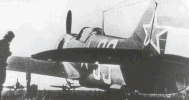 ......
......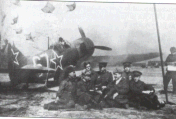
The preferred method seemed to be to repaint the inner wing section--up
to and including the joint strap-- with AMT-12. Perhaps this was seen to
be 'logical' given the large area of this colour near the cockpit area
on both sides of the fuselage in any typical NKAP Template scheme? In any
case, it is a recognizable pattern. "White 27", having been treated in
this way, might look something like this.
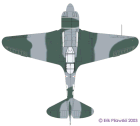
However, IF Kozhedub acquired a new aircraft during this pause--a
newly manufactured aircraft with all of the modifications included--then
the colouration would be quite different. Virtually all of the La-7s produced
between November 1944 and February 1945 were completed in a single-colour
upper surface scheme of AMT-11. We know this to be true not only from the
factory records, but also from the anecdotal reports of pilots (like Alelyukhin
and Dolgushin) who acquired La-7s from the factories at this time in person,
and painted them with their own creations. In that case, "White 27" would
have looked like this when delivered to the Regiment.
![]()
This possibility is more than highly mentionable. There are a number
of photographs of La-7s from the 176 GIAP dating from Feb-April 1945 (alas,
only one of "27"; see below). The vast majority of these show aircraft
finished in a single-colour application of AMT-11. Indeed, the only
clear exception to this observation seems to be the aircraft of Regimental
Commander Chupikov, "White 16".

"White 16" looked much as it did during August 1944, when it was photographed
for the first time. The only notable differences from that image were an
increase in the size of the AMT-12 coloured areas of the scheme (thus deviating
from the factory application), and a notable amount of this colour on the
wing central sections (as per the usual repair routine). Chupikov's La-7
in February 1945 is shown in photograph GMA 51-8 'Zh' [Park Pobedi].
Whatever meaning these speculations may have for the actual appearance
of "27" is unclear. We have only one, highly fractional, view of "White
27" during the period after this pause. This photograph dates from February
1945, and it shows us a small view of the nose of the aircraft. Typically
published views look like this image.
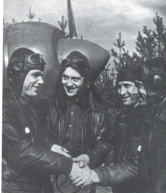
The original un-cropped photograph resides in the collection of the
TsDAK. It is framed, and labeled "140 - Vikh" on the back of the frame
(I do not understand what this reference means). This photo periodically
hangs on the wall in the Hall of the GPW, where it can be seen publicly.
The view in the original is not much wider, but it reinforces what we can
'tease' out of this view.
We can clearly see the thin white trim that edges the red 'triangle' features on the aircraft's nose. The forward cowling, itself, is certainly red in colour, as is the spinner. The stainless steel cowl band is not painted. These details are in very fine agreement with the later appearance of "27" in the museum at TsDAK, minus the spinner's colour. This view also suggests that "White 27" must have sported these embellishments at least from this time (Feb/45), and one might speculate, then, probably from the time of this break in activity (Oct-Dec/44). Sadly, there is no view of the fin in this image, and thus no evidence as to the appearance of any trim there.
Assuming a two-colour camouflage, "White 27" might have the following
appearance during February 1945.
![]()
And as here if we assume a single-colour scheme.
![]()
Alas, and perhaps surprisingly, that is all of the factual information available on the Wartime appearance of Kozhedub's aircraft. It never ceases to amuse (and amaze) me that this woefully inadequate description could be the progenitor of such a huge body of artistic and profile work!
Recollections: Sergey Kramarenko
In 1997 a series of interviews with S.M. Kramarenko were published in Czech magazine Aero Plastic Kit Review, starting it seems with issue no.64. The interviewer, S. Makarovich, asked Kramarenko specifically about service in the 176 GAIP, and Kozhedub's aircraft, which the latter claims to have piloted after Kozhedub left the Regiment. The following excerpts are from Kramarenko's answers, and were kindly provided and translated by Michal Sekula.
"Sometime during preparation of the 'Carpathian-Visla' Operation (Nov-Dec 1944) the 176 GIAP received new La-7 fighter planes...."
If this is so, then it is indeed very strong evidence in favour of the single-colour interpretation of "White 27". This testimony may explain just why so many 176 GIAP La-7s are finished in this way.
" [Following a mission on 11 Feb/45 ] ...Kozedub’s plane was slightly
damaged – two
hits to the fuselage and one hit to the tail."
If this damage were notable, could it explain some kind of repainting? Could it explain the repainting below the cockpit that might appear on the port fuselage? Could it explain a reason for adding AMT-12 in a two-tone application?
Kramarenko mentions further that he received Kozhedub's "White 27" after
the Deputy Commander was ordered to return to Moscow for the May Day celebrations.
He states that he piloted this aircraft until the end of the War, and that
it carried no "...small 'kill' stars nor three Hero of the Soviet Union
'Gold Medals' on the side....", which he asserts were painted later at
the Frunze Academy.
Victory and Embellishment
During May 1945, "White 27"--like so many VVS aircraft after the War--was
cleaned, polished, generally tarted up, and photographed. This is hardly
surprising, given the successful conclusion to a most barbaric war; the
pilots and soldiers of the Red Army must have been more than overjoyed
and exuberant. This "parade" appearance (if one may use that term) of "White
27" is the subject of the photograph with which the modern reader is most
familiar.
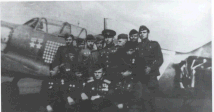
A close-up photo is also widely available of the cockpit area.
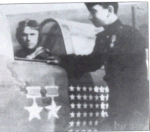
Many books have featured a version of this pictured printed in obverse
(opposite); in fact, it does indeed show the port side, as the larger photo
above.
What, then, do we see in these images? On the port fuselage below the cockpit there is some obvious, rather attractive, and very freshly applied artwork. This looks to demonstrate a number of 'kill marking' stars, probably in white. How many is not known. It may be that there are 62 of them, but Kozhedub's officially recognized score was not agreed in May 1945 (not even until August 1945 in his nagodniy list' for the third Gold Star HSU). Two HSU badges are present ahead of these markings over a wreath, these with a very nice 3-d star.
The date of 'May 1945' for this photograph is not discounted by Kramarenko's testimony. Kozhedub spent only about 3 weeks in Moscow, and was back at the 176 GIAP in Germany by mid-May. He states himself in his memoirs that he was conducting a training flight at the unit on 17 May when he learned that his father had passed away. It would seem to be the case that "27" was decorated after Kozhedub returned to the unit and reclaimed his machine.
The tactical numeral "27" was still in white, and featured no trim of any kind (as with its original appearance, no doubt). In the extreme upper right corner of the photograph there is just a hint of the fin/rudder flash that is so prominent on the Monino example photos [if this feature is not evident in this photograph version, I apologize for improperly cropping it].
As for the aircraft's colouration, many authors insist that this photograph demonstrates a two-colour scheme. Well, looking to the cockpit close-up, there is no doubt that a line of colour demarcation does run down the middle of the second HSU badge vertically. Is this appearance in agreement with the differences in tonal contrast between AMT-11 and AMT-12 lacquers on this film type? Yes, it is. However, does this area of colour contrast "prove" that "27" wore a two-colour camouflage? Obviously not.
Looking to the wider photograph, proponents of a two-colour interpretation
claim that colour demarcations can been in the locations marked on the
following picture.

I think that the best one might offer here is that such an analysis,
minus the clear colour demarcation on the fuselage side, is inconclusive.
What is needed is a fresh examination of the original photographic negative
(TsAMO PF f. 1418 32/1099/61, obkt. 1). It would be helpful as well
to generate new prints from this negative in the same process. Minus this
kind of evidence, this view will offer us nothing definitive on camouflage
colouration.
Returning our attention to the clear view of the cockpit area, here we might indeed see an area of AMT-12 paint. But, for what reason? Is this part of an NKAP Template camouflage application? Well, the placement of this demarcation is somewhat in line with these schemes, and this is possible. But, as well, virtually any explanation could be given for some paint in this location-- especially the conduct of minor repairs, which were required on 11 February. One interesting detail was pointed out only recently on a Russian language chat forum-- that no part of the canopy in this view appears to be coloured with AMT-12. This would make for a fairly unlikely factory camouflage scheme. The visible colour demarcation line is also not similar to the kind of semi-soft sprayed demarcation that we should expect to see on 1944 La-7 factory camouflage.
Now, if this machine were Kozhedub's one and only La-7 fighter, then it would have been subject to the inspections of Oct-Nov/44. We should then expect to see the large areas of AMT-12 colour on the wing centre-section. Whether such a feature is present in this view is just not clear.
Looking behind the pilot's heads, one does not see any obvious colour
demarcations where clearly there should be some.

Does this inform us that the colouration is, in fact, an upper surface
AMT-11 scheme as with so many 176 GIAP La-7s? If this lack of colour demarcation
is truly a feature of this image, it seems to show that this area of AMT-12
colour is a square, in fact placed directly under the white 'kill'
stars. Hmmm.
Or, is this observation a clue to a third interpretation-- that "White 27" was originally a single-colour AMT-11 aircraft that was refinished with one of the typical (and messy) field-applied 'Template' jobs? These were so random in nature that virtually any pattern could be explained by them, no matter how unlikely.
Looking to the above analysis, it seems that there are three primary possibilities:
1) That "White 27" was the original Kozhedub La-7 and was finished in
AMT-11/-12. In this interpretation we have to assume that the photograph
above is deceptive to a very large degree (not impossible with this kind
of 'journalist' type film), and that the various applications of AMT-12
are not evident for this reason.
![]()
2) That "White 27" was delivered in a single-colour AMT-11 scheme, and
remained in that colouration all of its life. This interpretation would
assume that "27" was not Kozhedub's original La-7, and that it probably
was manufactured and delivered during the pause in activities for the Regiment
(Nov-Dec/44). This kind of delivery date is quite realistic for these newly
manufactured machines; they were rushed to the front on an absolute priority
basis (and surely the 176 GIAP would have been a priority!). Kramarenko's
recollections seem to add weight to this view.
![]()
3) That "White 27" could have been finished in either manner, and that an indeterminate colouration resulted from the October/November inspections. In this case the interpretation would be that the areas of AMT-12 were either remnants of this work, or appliqué camouflage executed in the spring of 1945.
The third interpretation would preclude, by default, any colour profile
of "White 27". Since the details cannot be determined in the known photographs,
and no attributable pattern can be associated with the camouflage, there
is no way to render a drawing of the appearance of this aircraft. As well,
there is no evidence whatever about the appearance of the starboard side
fuselage; therefore, it seems inappropriate to assume that the various
kill markings and other artwork were present on this side at this time
(as in later appearances of "27").
After the Victory-- TsAGI
So, what then happened to Kozhedub's magnificent "White 27" after the War? To a point, this is--curiously-- the best documented part of this aircraft's life!
Kozhedub retained "27" during his stay in Germany. In August he was recalled to Moscow for his third award of the Gold Star, Hero of the Soviet Union. It is thought (and so mentioned by himself) that he flew "27" to Moscow. Kozhedub remained in the capitol for a considerable time following the award ceremony, and then was reassigned to other duties. His La-7, however, remained in Moscow. What happened to the aircraft then?
During 1945 a number of very far-sighted Russians were placing historically significant machines into various displays across the USSR relating to the Victory against Fascism. The Naval Museum in Leningrad, as well as the Defense of Leningrad Museum, were amongst the foremost proponents of this type of work, and the later GMA and Naval museums have their entire collections to thank for these fine efforts. In Moscow, this type of activity was taking place informally at TsAGI, at the LII, and at the TsDAK. Marshal Novikov, who commanded many illustrious aviation regiments, was known to be a vocal proponent of this idea.
In 1947 Marshal Novikov formally inquired about the possibilities to permanently house important aircraft in various State collections. The request was made directly to Voroshilov, who agreed that such collections should be authorized. In effect, this decision codified the aircraft collections which were already in place in Leningrad and Moscow (primarily). None of the later OKB Museums (which now remain) were discussed at this time. After this discussion, the LII handed over all of the machines it had been keeping (for these purposes) to TsAGI.
It seems that "White 27" also passed into the collection of the Zhukovskiy Institute (TsAGI) at this time, and was displayed informally for the students/staff at TsAGI. It is not clear if this aircraft had been in the custody of the VVS since 1945, but regardless it seems to have found a temporary home in 1947. Pravda mentions the existence of this aircraft at Zhukovskiy in a 1950 article, and so we can be pretty sure it was there during this general period.
In 1955 "White 27" was displayed in public to celebrate the 10th anniversary of the Victory against Fascist Germany. The aircraft was placed within a roped area in Red Square on what look to be red carpets, and a very attractive poster of Kozhedub was displayed next to the machine. Pravda printed a photograph of the aircraft in this condition in its 1955 Victory Day edition, and there is thought to be some 16mm movie film coverage of "27", as well (alas, I have never seen this). In this view, "27" looks to be finished in a single-colour AMT-11 scheme. The poster of Kozhedub, unfortunately, obscures most of the aircraft, but the white trim can be seen on the fin/rudder, and the numerals can be seen on the port side.
After the Victory parade, it appears that "White 27" was placed into the collection of the TsDAK. A general transfer of aircraft from TsAGI seems to have been undertaken about this time, and certainly the Sopwith Triplane and Voisin bomber were transferred in 1954 (as documented in the TsDAK collection). As was the general rule of the time, these aircraft were not exhibited publicly as there were no facilities at TsDAK to accommodate them, and the collection really acted as a type of protected storage. The lack of specific mention in the TsDAK records about "White 27" should not be seen to be unusual at all, and the collection there appears to have been a bit informal (see below).
In 1956 the VVS airfield at Monino was finally closed as a regular service operational air base. Hitherto, the airfield served mainly Il-4 bombers, and also a unit of Li-2 transports and the occasional Pe-2. Apparently the landing strip was deemed to be insufficiently long for jet aircraft requirements, and the so the operational history of Monino as a base came to a close. However, the VVS Academy was located at this facility, and it of course remained in operation. In 1956 the academy became the primary focus of Monino, as it remains today.
At this time, Marshal Rudenko, Commander in Chief of the VVS, and Marshal
Krasovskiy, Commander of the VVS Academy at Monino, developed an idea between
them to make a museum of "technical and
engineering interest" at Monino. This was seen to be the most suitable
location for such a museum, and that it would be of great interest to the
students of the academy. A number of ex- Il-4 repair hangars and workshops
were ear-marked for this endeavour, and perhaps some limited work began
in regards to their preparation for housing any subsequent facility.
However, in 1958 the Central Committee of the Communist Party passed a resolution stating that "...all out-of-date aircraft, including both machines and engineering, must be dismantled and reused as scrap metal for the needs of contemporary production...." Alas, the Soviet Government at this time showed no more foresight that other Governments and Air Forces world-wide, and many irreplaceable historical aircraft were ignominiously scrapped as a result. This resolution, happily, was never applied to any of the existing museum collections, but all of the 'informally' preserved aircraft were of course in dire peril.
Rudenko and Krasovskiy saw the danger at once, and reacted with speed. Work on the future museum at Monino began in earnest, and on 28 November 1958 Marshal Rudenko issued Order No.209:
"To create a museum attached to the Monino Militarily Air Academy for the exhibition of aircraft engineering of the VVS. The museum-exhibition will show the development and battle application of indigenous Soviet aviation technique."The Museum of the Military Air Forces of the USSR was officially codified on that date under the direction of Maj. K.P. Danilin of the Academy. Danalin was assisted by a Deputy Director from the 'active' VVS in the form of Gen-Mai. M.V. Shishkin. Despite the odd discongruity of ranks, the two men worked well together at the Museum.
The first aircraft in the Monino collection was in fact a DB-3 bomber which was reassembled from various parts in the very hangars which later housed the museum! These parts were left behind from the time of the airfield's service with Il-4s, and it is a very fitting historical addition to the collection. In 1960 the VVS Museum received a number of aircraft from various sources. From the Gromov Flight Institute a Yak-18 was obtained, and also some space/rockerty related memorabilia (about rockets in the VVS) from the Tsilokovskiy Institute. However, a large proportion of the new museum's collection came from the storage facilities of the TsDAK. Between 1958 and 1961 these included an La-11, La-15, Voisin, Farman, Sopwith Triplane, MiG-15, Il-10, Il-12, MiG-9, the famous ANT-2 "SSSR-1", and the most prized item of all, Kozhedub's La-7 "White 27". The majority of these aircraft were never listed in the collection at the TsDAK, and so it is not known how long they might have been kept there previously.
The following photograph was taken in the same location as the mystery
photograph above, and is usually captioned "1962 in Monino Hall No.1".
However, this caption must be incorrect, because the location is certainly
the Main Hall at the TsDAK. The Polikarpov TsKB-19 prototype can be seen
hanging above, and this aircraft was never part of the Monino collection.
The date is unknown, but might be from any time ca. 1955-61.
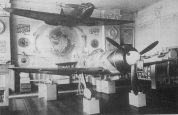
At this time, "White 27" appeared in a single-colour AMT-11 upper surface
finish. The undersurfaces have the correct appearance on this photo (K-39
film was used here) for AMT-7, and there is every reason to believe that
this was in fact the case. The details of the red 'triangle' features and
the white trim are identical to the Feb/1945 photograph, and the location
and nature of the upper/lower colour demarcation line on the lower cowling
is also consistent with this view. As well, the national markings are of
the more authentic white-border variety, and are notably
not
the
stereotypical 'Victory' types, while the numerals remain un-trimmed. The
spinner, however, is mysteriously painted white. The aircraft now sports
the various HSU and 'kill' marking artwork on both the port and starboard
sides. Hanging from the spinner, as well, is a framed version of the 1955
Pravda photograph of the machine at Red Square.
Looking carefully at the spinner, the answer to this mystery (anyway) might be revealed. It seems to be a replacement unit from an La-5. The spinners of the La-5 (up to and including the -FN) have a Hucks starter collar on the tip. Spinners for the La-7 do not. This spinner has a starter collar attachment point; it is not an original La-7 spinner. This unit is clearly, therefore, a replacement--the white is colour is explained thus. There is, alas, no way to know when this change took place (the spinner can't be seen in the 1955 Pravda photo), but likely the original spinner was damaged during the aircraft's long years of storage and occasional display.
Later (date unkown), this exhibit was revised. "White 27" remained on
blocks as the centre-piece of the Hall, but more items were added around
it (note the fuselage of a Bf 110 behind-- this was obtained from the LII).
A walking platform was added to allow visitors to see into the cockpit.
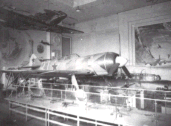
The colouration and markings of "27" look to be completely unchanged.
I believe that "white 27" probably looked as follows during its stay (1955-61)
at the TsDAK.
![]()
I have spoken at length to many of the staff of the Monino Museum from this time. There is unanimous agreement that "27" was never retouched nor refinished by the staff after its delivery from the TsDAK. It is therefore exceedingly difficult to reconcile the Monino appearance of "27" with these images, which must have been taken shortly beofre the aircraft was handed over from TsDAK.
It is most interesting that the aircraft, in its "1955-61" appearance,
looks to match the available evidence of its Wartime colouration extremely
well. There is simply no evidence on this aircraft that it was
ever refinished. The locations of the various painted items, like the tactical
numerals, nose trim, and even the camouflage colour demarcations are all
perfectly identical to the 1945 photographs. Of special note here are the
national star insignia, which had they been replaced would almost certainly
have been rendered with the thin red outline (the so-called 'Victory'
style star, which was the contemporary VVS insignia, as well). One can
state that the only omission in this record is a view from this time of
the port side fuselage. Would we see the large square of AMT-12 colouration?
Were all of the known photographs of "27" from this time taken from the
starboard side deliberately for this reason (that such a blob of colour
would be regarded as 'ungainly')?
Mystery, Catastrophe or Conspiracy?
The real mystery of "White 27" follows in what happened next. In 1965, the appearance of "27" changed, without explanation, permanently.
There have always been rumours about the fate of Kozhedub's aircraft at Monino. Some of the mooted Conspiracy Theories are pretty entertaining. However, the rumours of mishap are persistent, and credible. Many historians have examined the current La-7 specimen at Monino and found it to be unconvincing. I certainly have been one of these. When I pressed the staff for answers, I began to hear a lot of hushed rumours. The most notable of these came from such persons as the former Director Yakovlevich, who recalled that there was some kind of "accident" involving "White 27" during the 1960s. They refused, in every case, to be specific or to say any more. Whatever happened?
In 1965 there was some kind of "difficulty" with Hall No.1 at the museum. The museum's own records clearly show that this building was in a very sorry condition when it was allocated to the VVS Museum, and that it required constant repairs. No one at the museum questions this fact in any way. During 1965 Hall No.1 was suddenly closed to the public "for renovations".
During the celebrations of the 20th Anniversary of the GPW victory,
an La-7 aircraft went on display at Tushino. This aircraft was marked with
"White 27", and it bore a sign stating that it was the aircraft of "Three-times
HSU Kozhedub".

Suddenly, and inexplicably, "27" was now finished in an entirely new
way. The aircraft was painted with what looks to be a solid coat on the
upper surfaces of AMT-12 lacquer, including the stainless steel cowl bands
and the plates aft of the exhausts. The star national markings from the
fuselage sides were gone. The 'parade' markings are completely different,
and drawn in different colours. The tactical numeral "27" were trimmed
with a thin blue stripe, and the font style of the numbers had shifted
slightly. A pair of utterly stupid and spurious national stars appeared
on the wing upper surfaces. The star marking on the fin/rudder was much
larger than previously.
All of the facts lead to the inescapable conclusion that IF this machine was indeed "White 27", it had been completely and comprehensively refinished. The other possibility is that this aircraft was not "White 27", which begs the question of why it was labeled in this way?
After the end of these celebrations in May 1965, Hall No.1 reopened
at Monino. However, visitors would have been surprised to see that "White
27" was no longer located there. In fact, an La-7 bearing a perfect resemblance
to the machine just displayed at Tushino was located in a back corner of
Hall No.6, well out of the way of the public walkway. This machine was
labeled only by a small A4 sized card stating that this was "Kozhedub's
famous La-7".
How on earth does "White 27" go from museum centre-piece
to storage closet recluse, and so suddenly !?! To put what would arguably
be amongst the five most priceless aviation artifacts in the world into
this location seems beyond comprehension.

This photograph, from Monino's own visitor's brochure, is poor to say
the least. What we can see in this picture, which certainly dates from
the 1965-71 period, is that the spinner of "White 27" is white. Eyewitness
accounts of the machine in this location state unanimously that it was
finished exactly as the Tushino 1965 appearance, including the hideous
upper wing surface star markings.
Another curious view of "White 27" is available from Monino. This picture
comes from a different VVS Museum brochure (which I saw myself in the lobby
of the Leningradskaya Hotel), and sadly I have no idea how to date
it. This image, again poor, seems to throw the matter of this aircraft's
colouration into even greater confusion.

This aircraft seems to be finished in what looks to be a single-colour
finish of AMT-12. The various camouflage details such as the upper/lower
colour demarcations, and so on, are not evident. The national marking on
the fin/rudder seems to agree with the appearance of the same features
on the 1965 Tushino "White 27". However, no numerals of any kind are present
on the starboard fuselage, and the 'parade' artwork has been repainted
in yet another style once again. The stainless steel cowl bands are exposed,
which does not agree with the Tushino view, but the exhaust plates are
painted (which does). Most intriguingly, however, we see a 'replacement'
La-5 spinner, but this unit still has the Hucks starter collar attached!
The current appearance of "White 27" was established in 1972 when the
museum was expanded and reorganized into its current form (this is confirmed
by eyewitness accounts of the exhibit at the 1972 re-opening). At this
time, some 'Victory' type national stars were added to the aircraft, and
the undersurface was 'touched up' (I am not sure what that means).
Here is a photograph which I took in 1990.

Here is another (taken by others) from 2001.

Also at this time "27" was moved to Hall No.3, where it remains today.
This is Hall is dedicated to the history of the GPW period, and therefore
the location seems suitable for "White 27", despite the fact that many
of the exhibits in this hall are, indeed, replicas.
Looking closely at this specimen, one can see many problems. The cowling is heavily off-set, and crooked. The barrels of the (alleged) ShVAK are actually sticking out of the front of this unit. Absolutely no one is allowed to open or access the engine compartment, presumably to conceal the extreme difficulties that would be seen there. The cooling louvres are tightly shut, but peering in through the exhaust channel flaps one can see that much of the engine compartment is missing. There appears to be some kind of internal structure, and there are certainly no exhaust pipes exiting through these channels [however, recent photographs of the exhibit show some kind of engine inside the compartment]. One wonders if the ASh-82 motor sitting on the floor adjacent originally came from this machine?
The aircraft now, mysteriously, has a proper La-7 type spinner. Where is "White 27s" La-5 replacement unit? The colouration looks indeed to be AMT-12 on the upper surfaces, but it is clearly AII Blue on the lower; how can one explain such a scheme? Why was this exhibit allegedly repainted in its entirety in 1965, anyway? Why were the original markings and colouration not replicated when it was? Why is the cockpit the only surviving La-7 specimen's in the world not to be finished in ALG-5 (as the Gor'ki and Moscow Production Diaries say it should), but rather in the pre-War method using A-14 lacquer?
To regard this long (and, frankly, very incomplete) list of problems
as merely "difficult" would be to demean the word through understatement.
Conclusions
What do we make of the long and complicated history of "White 27"? What conclusions regarding its appearance, if any, can be drawn?
Regarding the Wartime appearance of "White 27", there is no definitive answer. I would suggest that the most likely answer, however, is still that the aircraft was finished in a single-colour AMT-11 camouflage. This interpretation, to my mind, matches the facts most closely, and requires the fewest unusual assumptions.
I see no evidence--none--that "27" was repainted up to 1961 prior to being placed in the museum at Monino. This aircraft was in the care of TsAGI for most of its post-War life. We know from other examples that this organization was exceedingly professional and careful in the preservation of historic specimens. The Sopwith Triplane, for example, dates from the Russian Civil War and it is still in breathtakingly accurate and authentic condition. This surely was the fine work of TsAGI, who retained the aircraft for all of its early 'museum' life. I regard it as very logical that such an important and valuable exhibit as "27" would have been maintained at Zhukovskiy in similar fashion. In the same vein, I suspect that the replacement spinner was most likely added while the machine was in the TsDAK collection's storage. It is therefore the most reasonable assumption, in my mind, that the appearance of "White 27" as photographed in 1955-61 is essentially the same appearance it had in May 1945. The only obvious change would the addition of the third HSU badge, and at this time possibly the execution of the 'parade' artwork on the starboard fuselage side.
One considerable source of trouble for this kind of investigation is that there are no known views of "White 27" early in it's stay at Monino. The curious unknown views might date from this era, but there is no way to tell. The establishment of the aircraft's appearance during 1961-65 would be extremely helpful in understanding the course of events which followed that time.
The current exhibit at Monino is undoubtedly the same aircraft that appeared at the Tushino display in 1965. The appearance and details are identical, and these are known (through photography) to have been essentially unchanged (with the modifications being progressive) since that time. The situation involving the cowling is mysterious; even the 1965 example seemed to be in mechanical order. It seems clear that some sort of mishap overtook this aircraft since 1965.
The current "27" shows evidence of repainting in some locations, but always with the same AMT-12 finish. There is absolutely no evidence anywhere on this aircraft's upper surfaces that it has been painted with any lacquer other than AMT-12. I have personally examined some of the areas of this exhibit in detail, and I am certain beyond any doubt that, in these examined areas, this is so. Moreover, the wing upper surfaces do not demonstrate any signs of the usual primers (ALG-1 would be expected), indeed priming of any kind, nor the existence of filler putty. Such a condition is completely inexplicable.
With the above analysis one matter is patently clear, and bit disturbing. It is simply not evident how one can reconcile the various known appearances of "White 27" with the current Monino exhibit "White 27". Since the current exhibit seems pretty clearly to have been painted with AMT-12 all of its life, how can this aircraft then be either an originally two-colour AMT-11/-12 camouflaged "White 27", or a single-colour AMT-11 camouflaged "White 27"? How do the various appearances of "27" make a coherent picture? What is the date of the unknown image of "27" with details of both the TsDAK version and the 1965 Tushino version?
The first possibility is certainly the worst-- that a disaster struck the aircraft during, or prior to, 1965 and it was destroyed. It is worth noting that the TsKB-19, which was photographed hanging above "27", disappeared from the TsDAK collection and has never been seen again. The date of the building 'difficulties' which affected the Hall where "27" was stored at Monino also coincide with the new coluration of the exhibit. The appearance of the Tushino example could then be explained as a 'replacement' La-7, and therefore not the original Kozhedub aircraft.
The second possibility is that the exhibit was comprehensively rebuilt at some time following a mishap. This might possibly explain some of the oddities with the current museum "27". This idea would pre-suppose a considerable amount of refinishing prior to this mishap. Moreover, it would require that this repainting work would have been of alternately superlative and inept quality.
The third possibility is that "White 27" was deliberately refinished in a way that obscured the previous appearance(s). One can only guess at a motivation for such illogical behaviour, but it would be technically possible, and it might explain certain problems with the current exhibit.
Perhaps another explanation can be found to reconcile these facts. Alas, I cannot think of what that may be at this time.
What is crystal clear, however, is that help is needed desperately from the Russian Air Forces Museum at Monino. An exhibit of the La-7 fighter aircraft of Ivan N. Kozhedub is a historical treasure of unimaginable significance and value. Surely, with such serious and demonstrable concerns over the current and historical appearance of this specimen, the Museum must help all historians to ascertain the true and verifiable record of this exhibit. In brief, what is critically required at this time is:
Until such time, the current exhibit at Monino of "White 27" must
appear to be incongruous with the evidence (such little as it is) we have
of its historical finish and detail. I simply cannot see any way, or any
theory, which explains these problems to any satisfactory degree. Well,
save for one-- and that possibility is exceptionally ugly and disturbing,
and I would prefer to hope that it is not true. I call on the outstanding
staff at Monino, all professionals and dedicated to aviation matters and
historical research, to re-examine "White 27" in the collection and help
us understand these profound and potentially serious mysteries.
Should anyone have an additional
photographs of "White 27" in any condition, or any additional information
on this matter, I would be deeply grateful to hear from you. Until such
time, the preceding work represents my own conclusions on the disposition
of this aircraft according to the best currently known evidence.
| Single-Colour Finish | Two-Colour Finish |
| 1944 | ||
| February 1945 | ||
| May 1945 | ||
| 1955-61 |